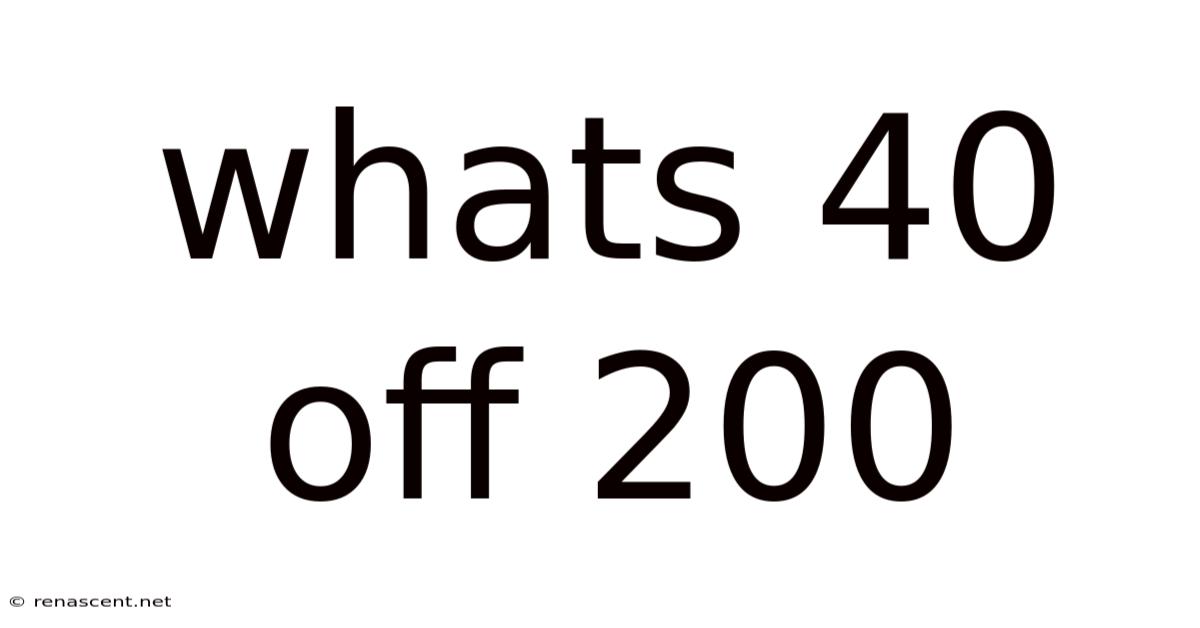Whats 40 Off 200
renascent
Sep 15, 2025 · 4 min read

Table of Contents
What's 40% Off 200? A Comprehensive Guide to Percentage Calculations
Calculating discounts is a crucial skill in everyday life, whether you're shopping for groceries, comparing prices for electronics, or understanding financial deals. This article provides a comprehensive guide to calculating 40% off 200, explaining the process step-by-step, exploring different calculation methods, and expanding on the broader concept of percentage calculations. Understanding these principles empowers you to confidently navigate discounts and make informed purchasing decisions.
Understanding Percentages
Before diving into the calculation, let's refresh our understanding of percentages. A percentage is a fraction of 100. The symbol "%" represents "per hundred" or "out of 100." So, 40% means 40 out of 100, which can also be written as 40/100 or 0.4 as a decimal.
Method 1: Calculating the Discount Amount
The most straightforward way to find 40% off 200 is to first calculate the amount of the discount and then subtract it from the original price.
-
Convert the percentage to a decimal: 40% = 40/100 = 0.4
-
Multiply the original price by the decimal: 200 x 0.4 = 80
-
This result (80) represents the discount amount. This means a 40% discount on $200 is $80.
-
Subtract the discount from the original price: 200 - 80 = 120
Therefore, 40% off 200 is $120.
Method 2: Calculating the Final Price Directly
Alternatively, you can calculate the final price directly by finding what percentage of the original price you will pay after the discount.
-
Calculate the percentage remaining after the discount: If you're getting a 40% discount, you'll pay 100% - 40% = 60% of the original price.
-
Convert the remaining percentage to a decimal: 60% = 60/100 = 0.6
-
Multiply the original price by the decimal: 200 x 0.6 = 120
This directly gives you the final price after the 40% discount: $120. This method is often quicker and can be less prone to errors.
Method 3: Using Proportions
Proportions offer a more visual approach to solving percentage problems. We can set up a proportion to find the discount amount:
-
Let x be the discount amount.
-
We can set up the proportion: x/200 = 40/100
-
Cross-multiply: 100x = 200 * 40
-
Solve for x: 100x = 8000 => x = 8000/100 = 80
Again, the discount amount is $80, and subtracting this from the original price gives a final price of $120.
Understanding the Mathematical Principles
These methods all rely on the fundamental principles of percentages and fractions. A percentage is essentially a ratio expressed as a fraction of 100. Multiplying the original price by the decimal equivalent of the percentage allows us to calculate a proportional amount. Subtracting this amount (the discount) from the original price gives the final price after the discount is applied.
Expanding on Percentage Calculations: Real-World Applications
Understanding percentage calculations extends far beyond simple discounts. Here are some real-world applications:
-
Sales Tax: Calculating sales tax involves adding a percentage to the original price. For example, a 6% sales tax on a $100 item would be calculated as 100 * 0.06 = $6, resulting in a total price of $106.
-
Interest Rates: Interest rates on loans and savings accounts are expressed as percentages. Understanding these percentages is crucial for managing personal finances and making informed borrowing or investment decisions.
-
Tips and Gratuities: Calculating tips in restaurants often involves estimating a percentage of the total bill.
-
Profit Margins: Businesses use percentage calculations to determine their profit margins, which represent the percentage of revenue remaining after deducting costs.
-
Data Analysis: Percentages are essential for analyzing data and expressing information concisely. For example, representing survey results or statistical findings often uses percentages to show proportions.
-
Grade Calculation: Many grading systems use percentages to represent a student's performance in relation to the total possible points.
Frequently Asked Questions (FAQs)
Q: What if the discount was a different percentage?
A: The same methods apply. Simply replace the 40% with the new percentage and follow the steps outlined above. For example, to find 25% off 200, you would calculate 200 * 0.25 = 50 (the discount) and then 200 - 50 = 150 (the final price).
Q: Can I use a calculator for these calculations?
A: Absolutely! Calculators are a valuable tool for performing these calculations quickly and accurately. Most calculators have a percentage function (%) that simplifies the process.
Q: What if the original price wasn't a whole number?
A: The methods remain the same; you would simply perform the calculations with the decimal value of the original price.
Q: How can I improve my understanding of percentage calculations?
A: Practice is key! Try working through various percentage problems with different percentages and original prices. You can also find many online resources and practice exercises to enhance your skills.
Conclusion
Calculating 40% off 200, resulting in a final price of $120, is a simple yet fundamental application of percentage calculations. Mastering this skill empowers you to confidently handle discounts, sales tax, interest rates, and various other real-world applications involving percentages. Understanding the underlying mathematical principles allows you to approach such problems systematically and accurately, regardless of the specific numbers involved. By practicing these methods and understanding the broader applications of percentage calculations, you can significantly improve your financial literacy and make informed decisions in numerous aspects of your life.
Latest Posts
Related Post
Thank you for visiting our website which covers about Whats 40 Off 200 . We hope the information provided has been useful to you. Feel free to contact us if you have any questions or need further assistance. See you next time and don't miss to bookmark.